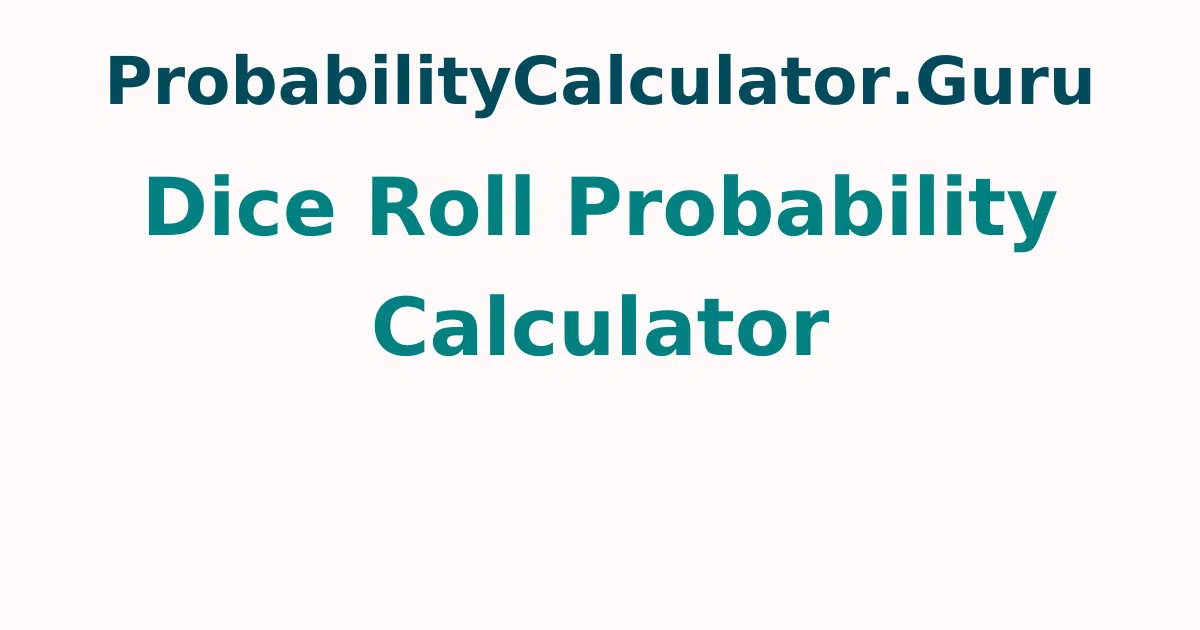Dice Roll Probability Calculator
Created By : Vaibhavi Kumari
Reviewed By : Phani Ponnapalli
Last Updated : Mar 23, 2023
This Dice Roll Probability Calculator or dice rolling probability calculator is a tool that helps you not only find the dice probability, but also gives every single step included in solving the dice probability. You just have to provide the number of dice rolling, conditions in the input boxes and press the calculate button to get displayed with the accurate answer quickly.
What are the different Types of Dice ?
A dice is a 6 sided object which has all sides of equal length and which is used to play games. Every dice has numbers from 1 to 6 on each face. The different types of dice are listed here:
- A dice that has 4 sides is the tetrahedron. Each face is an equilateral triangle.
- A dice which has 6 sides is the classic cube. Each face is a square.
- 8 sided dice is called an octahedron. Each face is an equilateral triangle.
- 10 sided dice is called a pentagonal trapezohedron. Each face is a kite.
- 12 sided dice is called a dodecahedron. Each face is a regular pentagon.
- 20 sided dice is called a icosahedron. Each face is an equilateral triangle.
Steps to Calculate Probability of Dice
Probability calculator dice, The simple steps to find the probability of a rolling dice are given here. Follow these guidelines to get the answer in a matter of seconds
- Initially, identify how many dice are rolling which is n.
- From that the total number of possible outcomes be 6n.
- Based on the condition provided at the question, make a note of the favorable outcomes.
- The ratio of the number of favorable outcomes to the number of possibilities is the probability.
Example Questions on Dice Rolling Probability
Question 1: A dice is rolled 2 times. What is the probability of getting same numbers?
Solution:
A dice is rolled 2 times.
So, number of possible outcomes are 6² = 36
Favorable outcomes for getting 2 numbers same is {(1,1),(2,2),(3,3),(4,4),(5,5),(6,6)}
The formula to find probability is No. of favorable outcomes/Total No. of possible outcomes
The probability of geting same numbers when a dice is rolled 2 times = 6/36 = 1/6.
Question 2: A dice is rolled. What is the probability of getting a number lying between 3 and 6?
Solution:
A dice is rolled once.
So, the number of possible outcomes are 6
Favorable outcomes for getting a number lying between 3 and 6 is {4, 5}
The formula to find probability is No. of favorable outcomes/Total No. of possible outcomes
The probability of getting a number lying between 3 and 6 when a dice is rolled is 2/6 = 1/3.
Stay tuned our website Probabilitycalculatorguru to get the quick results on more calculators related to the concept of probability.
FAQ's on Rolling Dice Probability Calculator
1. How do you find the probability of a dice roll?
Mathematically, the probability is the ratio of the number of desired outcomes to the total number of possible outcomes. When a dice is rolled once, then the possible outcomes are 6. So, the probability of a dice roll is a number of the desired outcomes/6.
2. What is the probability of rolling 3 dice and getting the sum of 9?
If a dice is rolled 3 times, then the number of possible outcomes are 63 = 216
The possibilities of getting sum of 9 are {(3,3,3), (2,4,3), (3,4,2), (2,3,4), (4,2,3), (1,4,4), (4,1,4), (4,4,1), (2,5,3), (2,3,5), (5,2,3), (5,3,2), (3,2,5), . . }
Probability of getting the sum of 9 for 3 dice = 25/216.
3. What are the total outcomes when a dice is rolled 4 times?
The total number of possible outcomes when a dice is rolled 4 times is 64 = 1296.
4. What is the probability of getting a number that is multiple of 4 when a dice is rolled 2 times?
The total number of possibilities are 6² = 36
Favorable cases 3 + 5 + 1 = 9
So, the probability of getting a number that is multiple of 4 when a dice is rolled 2 times = 9/36.
